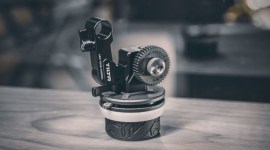
Basic Camera Filtration to Elevate your Cinematography
Filtration for your camera can be a essential to creating the most cinematic images. Here’s what you need to know.
Cover image via Shutterstock.
With a wide variety of available filtration options, choosing the right tool to enhance your story can be challenging. I’m going to walk you through the three most common types of filtration that you may come across. Each type of filtration is an essential filmmaking tool, with a unique purpose, to help you tell your story effectively.
Neutral Density
Neutral Density filters, or ND filters, are a key component of crafting cinematic images. One of the most common uses of ND filtration is to darken your image in exterior daylight, allowing you to open up your lens aperture to create a more shallow and cinematic depth of field.
ND filters come in all different strengths. The “lightest” ND is a .3, which reduces the exposure of your image by 1 full stop. The next step up is .6 which is two stops. Incrementally each additional stop of light is measured as .3 more than the previous. So for example, a 3 stop light reduction would be ND .9, and 4 stops would be an ND 1.2.
ND filtration is available in all sort of sizes from a 52mm thread that attaches to the front of your lens to a 4×5.65 sheet that drops into the matte box of your camera.
Polarizers
Polarizers are one of the best kept secrets in the film world. They’re great tools that can drastically enhance the quality of your footage, providing you with far more cinematic and vibrant images. I have to admit that I didn’t start using polarizers until very recently. Once I began to use them, I finally realized how powerful they can be. Polarizers have many usages. They can create bluer skies, minimize reflections on car windshields, or see more clearly into water.
Much like NDs, polarizers also come in circular models that you can thread to the front of your lens or in 4×5.65 rotating applications.
Diffusion Filters
With today’s modern digital cameras and lenses, sharpness is king. However, with so much sharpness in images now, cinematographers are looking for ways to soften their images to make them appear smoother and more fluid. This is where diffusion filters step in. Diffusion filtration does three jobs: it softens the image, blooms the highlights, and lifts the shadows and contrast. These three elements help to take the edge off today’s sharp digital images. However, what makes diffusion filtration great is that even though it reduces some of the digital sharpness, it still produces a cinematic image that doesn’t look soft-focused.
Below is a nearly comprehensive test of all of Lee’s various diffusion filters. This test should help you see how powerful diffusion filters can be and what type of look each variety offers.
For more on camera filtration, check out these articles:
- The Five Lens Filters Every Video Shooter Should Own
- Manipulating the Invisible Spectrum With ND Filters
- The World of Diffusion Filters






